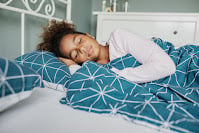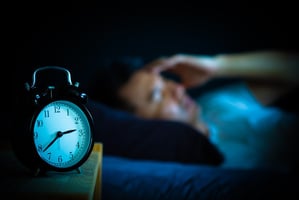Sleep Problems in Late Childhood, Early Adolescence Linked to Psychiatric Symptoms

Children aged 9 to 13 who experience sleep problems may be more likely to experience internalizing symptoms (such as depression and anxiety) and/or externalizing symptoms (such as aggression and rule-breaking behaviors) than children who do not experience sleep problems, according to a report in JAMA Psychiatry.
“Our findings emphasize the need for early identification and treatment of sleep problems in childhood to ameliorate or potentially prevent mental health difficulties in early adolescence,” wrote Rebecca Cooper, M.P.O., and Vanessa Cropley, Ph.D., both of the University of Melbourne, and colleagues.
The researchers analyzed data collected from 10,313 participants whose caregivers completed the Sleep Disturbance Scale for Children (SDSC) as part of the Adolescent Brain Cognitive Development (ABCD) Study when the youth were between the ages of 9 and 11 years and again two years later. Using the SDSC, the caregivers were asked about the youth’s experiences over the prior six months with such sleep problems as sleepwalking, nightmares, night sweats, sleep breathing disorders, troubles falling and/or staying asleep, and more. The caregivers also completed the 113-item Child Behavior Checklist, which asked about any internalizing or externalizing symptoms displayed by the youth in the previous six months.
The children were then categorized into four sleep disturbance profiles at baseline and at two-year follow-up:
- Low disturbance (25.2% at baseline; 30.3% at follow-up).
- Sleep onset/maintenance problems (16.0% at baseline; 32.6% at follow-up).
- Moderate and nonspecific disturbance, or “mixed disturbance” (42.3% at baseline; 22.1% at follow-up).
- High disturbance (16.5% at baseline; 15.0% at follow-up).
Compared with youth in the low sleep disturbances group, those who reported greater sleep problems had a greater risk of both internalizing and externalizing symptoms at baseline and at the two-year follow-up than those in the low disturbance profile. For instance, those in the high disturbance profile were 1.44 times more likely to experience internalizing problems and 1.24 times more likely to have externalizing symptoms than children in the low disturbance profile.
“[T]he strongest associations were observed for somatic distress, with an approximate 60% increase in symptom severity between the low disturbance and high disturbance profiles,” Cooper and Cropley wrote. “Clinically, these findings underline the importance of routine assessment and management of both sleep and psychopathology symptoms in youth, with special emphasis on symptoms of somatic distress.”
They concluded, “Follow-up of individuals in each of the sleep profiles will elucidate the developmental trajectory of different sleep problems into mid and late adolescence and their prospective association with later mental health outcomes.”
For related information, see the Psychiatric News article “Studies Highlight Impact of Sleep on Mental Health of Youth.”
(Image: iStock/Milko)
Don't miss out! To learn about newly posted articles in Psychiatric News, please sign up here.






